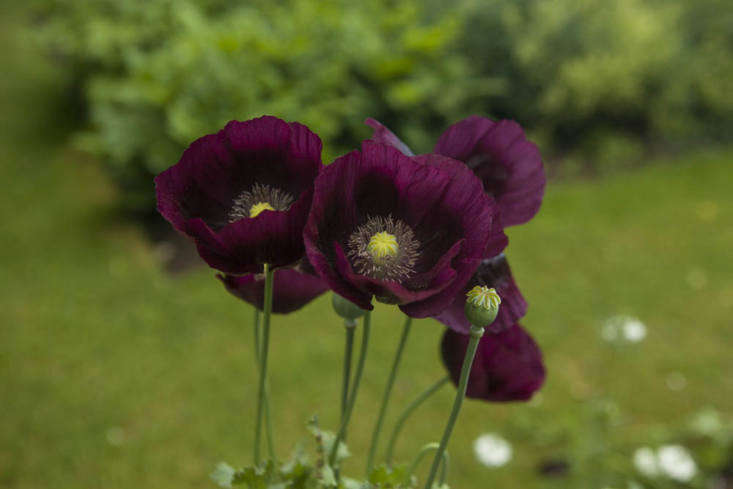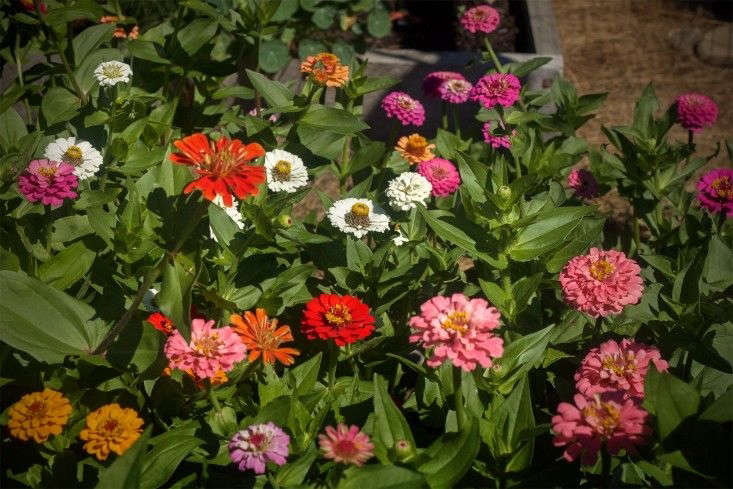I must confess, at the beginning of my landscaping career I was not a big fan of annuals. In fact, I turned my nose up if clients wanted me to add them into the design. I thought: Those trite, garish, and annoyingly fussy things that quickly expire? You might as well throw your money into the compost. But now with years of learning, I've become enlightened. I am a convert, if you will. I now understand the reason for annuals, how they can be valuable in a design and how to properly work with them to maximize their beauty and function.
Yes, I am now a planter of annuals (and quite a lot to be honest). With that proclamation, here are some lessons learned that hopefully will help you fall in love with these misunderstood plants, or maybe even spice up an existing love affair with them.
1. There's a good reason annuals have a short life span.

Above: Deep plum-purple opium poppies at Oxford Botanic Garden. Photography by
\/www.theguardian.com\/profile\/jim-powell","category":"Outbound","action":"click"}">Jim Powell for Gardenista, from
Gardening 101: Opium Poppy.
Annuals sprout, bloom, produce seeds, and die all in one growing season–unlike perennials which live for more than two years. Most perennials use a ton of energy establishing their root systems and sometimes at the expense of producing flowers. Annuals, on the other…petal, use their resources to produce flowers and seeds instead of their roots that eventually die at season's end.
2. Every garden can benefit from annuals.

Above: Wondering how to mix and match colorful zinnias with the rest of your flowers? See
Family Matters: Restoring a Historic Landscape in Concord, MA. Photograph by Justine Hand.
Think about it this way, if your garden held a performance, the leading actors and actresses would be the perennials and the annuals would be the supporting characters. So think of planting annuals to fill in around a focal plant in a container, to decorate the bare feet of a shrub, to extend the blooming period in your garden and—sometimes—provide a continual nectar source for pollinators when perennials haven't started flowering or are slowing their roll. Annuals live to provide quick, easy, colorful, long-blooming color, and are relatively inexpensive, to boot.
3. There are annuals that are actually perennials.

Above: Dahlias are tender perennials and will live just one year if left in-ground to over-winter in certain zones. Photograph by Jim Powell, from
Dahlia Days: Sam McKnight's Spectacular September Garden.
Some perennials that aren't hardy in various zones are used as annuals. Examples include: lantana, verbena, New Guinea impatiens, and dahlias (if not dug up and stored). Another good example are pansies which are short-lived perennials usually sold and grown as cool-weather annuals. (For more on this topic, see The Garden Decoder: What Are 'Annuals' (The Answer May Surprise You).
4. And there are some that act like perennials.

Above: Nasturtiums spill over the edge of a raised bed. Photograph by Mimi Giboin for Gardenista, from
Before & After: An Artful Gravel Garden in Sonoma, California.
The fact that some annuals grow back next season is a real bonus. They do this by cleverly reseeding themselves around your garden if you don't deadhead them and instead let them go to seed at the end of their flowering season. Good volunteers: nasturtiums and alyssum.
5. You'll want to stay clear of "bully" annuals.

Above: Michelle grows cosmos in her Northern California garden, where it isn't invasive. Photograph by Michelle Slatalla, from
Gardening 101: How to Deadhead Flowers.
Every hero needs a villain. And in this case, there are some annuals that can be a bully by excessively self-seeding and naturalizing outside of the garden where they displace native plants. Cosmos bipinnatus, native to Mexico, has been found to be invading parts of the Mid-Atlantic. Nigella damascena is another rampant re-seeder but can be curbed by removing the seed pods before they explode open. Keep in mind that a plant listed as vigorously self-seeding in one state may be well-behaved and welcomed in another so check local resources if there is a question.
6. Pollinators may prefer perennials.

Above: Asters are an annual that pollinators do love. Photograph by Jim Powell, from
Can This Garden Be Saved: 'My Garden Collapses After June'.
Despite some annuals boasting flouncy flowers, not all are enticing to our pollinating friends. Often cultivars bred for human appeal (like fancy double flowered types) sacrifice other traits such as lower quality nectar or fragrance. Also, native pollinators would rather visit native plants better suited to the local environment—another reason to plant natives.
7. You can grow some annuals from seed.

Above: Sweet peas are easy to grow from seed. Photograph by
\/www.kendrapagewilson.com\/","category":"Outbound","action":"click"}">Kendra Wilson, from
Ask the Expert: The Best Sweet Peas to Sow for Spring.
There is a technique called "direct sowing" where you plant your seeds in the garden right where you want them to grow. Top seeds to try this: zinnias, marigolds, sunflowers, nasturtiums, and sweet peas. Also, by planting annuals from seed you can grow some unique varieties that the nurseries don't sell as starts, and a seed packet is way cheaper than a bunch of 4-inch or cell packs.
8. For best results, you'll need to plant them right away.

Above: Photograph by Sara Barrett for Gardenista, from
Flower Borders: 10 Essential Tips from White Flower Farm's Barb Pierson.
Annuals should be in the ground or pots as soon as possible after being purchased. And definitely don't purchase annuals bursting at the seams of their plastic pots or let them outgrow the pots as this weakens and stresses them. Also, when choosing annuals in the store look for young plants not flowering as they will acclimate better to their newly planted location. Last, water immediately and thoroughly after planting even if rain is expected.
9. Annuals are hungry (and thirsty).

Above: Lobelias require moist soil. Photograph by
\/www.flickr.com\/photos\/30775955@N02\/5937160238\/in\/photolist-f48Dvb-e8SQqx-bfniGZ-49jH8H-6UEFBt-2C1aw7-owUU7o-8qTTbd-bVqcHH-4SBrYv-9YNGsA-roKwWX-FmBTpb-pJWTcD-f96s5W-7mLbs7-o8TKGD-3FzcZa-VryVK8-4SGcVS-QjqQgq-4ugV3E-o7NBH7-91h1ec-oYLM8j-PVN4Ta-oGz18b-3GvX9K-5LQbYy-e7cGPY-aw64Yd-guUCZx-83e4io-cB5xk5-f6CLmw-5MvWZq-gS6NTx-a9vncv-afJbVZ-roLFwd-roY2sg-4SBsPg-cFoyYA-4SFUEm-9Fjb4T-wWkreo-cSB7V5-hjH9Ti-a3DuTG-4SFZUE","category":"Outbound","action":"click"}">Mike Sutton via Flickr, from
Gardening 101: Lobelias.
A lot of energy is spent on setting buds and blooming, so even if your annuals are in organically rich soil, they still appreciate being fed every month with a water-soluble organic fertilizer. Annuals are also thirsty because they aren't blessed with a deep root system so even water-conscious annuals bloom better with regular water. Tip: When the soil feels dry about one inch below the surface, it's time for a drink (the plant, not you).
10. And they need primping, too.

Above: Erin Benzakein, of Floret Farm, surrounded by sweet peas. "You'll get a lot more flowers if you deadhead through the whole season," she says. Photograph via Floret Farm, from
Ask the Expert: 7 Tips to Grow Cut Flowers in a Tiny Garden, from Floret Farm.
To encourage and ensure a continuous bloom, annuals need routine grooming, and by grooming I mean flowers should be deadheaded right after they fade. This is critical for older flower varieties that horde their old flowers such as sweet peas, cosmos, snapdragons and zinnias. If your annuals look ragged midsummer, go ahead and prune them back several inches to encourage new, tidier growth and a happy re-bloom.
For more in the series, see: